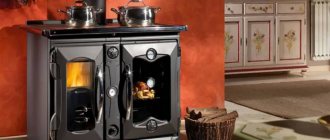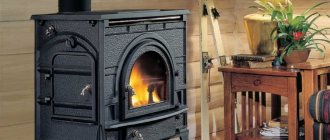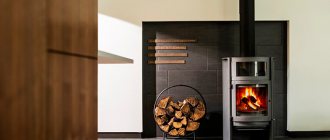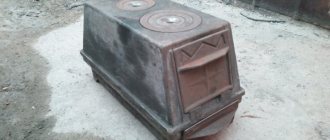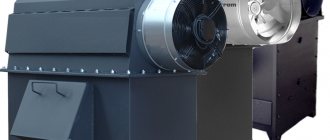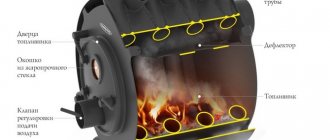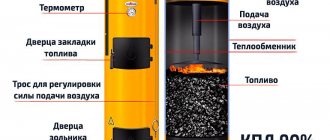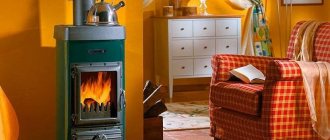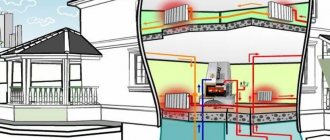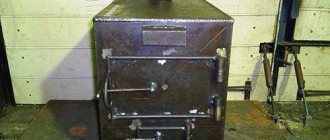- Buleryan
Every home during the cold season needs high-quality, reliable and highly efficient heating. In conditions of high energy prices, many buyers are trying to save money. Therefore, despite the abundance of modern solar systems, “warm electric and water floors,” gas and electric boilers, owners of private and commercial real estate are increasingly returning to a long-burning wood-burning heating stove for their home. It is a useful aid in the autumn-winter period and a wonderful interior decoration. In our article we will look at the operating features of such devices, their varieties, and tell you what to look for when choosing.
Design
Structurally, devices with slow combustion of fuel are divided into two types - with a built-in water circuit and without it. In the first case, the installations are used to heat buildings with a fairly impressive area. They are connected to a heating system with installed radiators, heating tanks and pipe distribution. Such a purchasing decision will cost much more than installing a contourless product. However, the investment pays off over time - the house will be heated from the device, which provides autonomy for up to 12 hours on one load of fuel briquettes.
Stoves that are not equipped with a water outlet are also capable of heating large volumes, but within the same room. The manufacturer always describes the physical and operational capabilities of the equipment in the technical documentation. Therefore, before purchasing, you need to carefully study it to ensure it meets your requirements.
Furnaces with water circuit
The hydro circuit, which is equipped with many models of stoves with the “long burning” function, is an extremely significant advantage and provides a number of amenities that significantly increase the level of comfort of those living in the house. The principle of operation of the hydraulic circuit is the circulation of the coolant - water - through the heat exchanger of the furnace, located in close proximity to the combustion chamber. Heated by fire, water flows from the stove to other functional elements and systems connected to the unit.
The following can be connected to the furnace water circuit:
- boiler
- radiators and radiators in selected rooms
- "warm floors" system
The water circuit allows you to organize the operation of not only the heating system, but also the hot water supply of the entire house. This option is extremely comfortable, especially in suburban conditions, and economical, since the user does not need to spend any additional resources to ensure the operation of the hot water system. The water circuit allows you to use fuel and a long-burning system with maximum benefit and efficiency. The generated thermal energy will be supplied to the radiators in the selected rooms, as well as to the boilers.
Important! The water circuit is almost the only way in which it is possible to organize an autonomous and independent heating and hot water supply system for the entire house, provided that stove equipment is used.
Operating principle
Devices with long fuel combustion, when compared with conventional traditional designs, are more economical and efficient. This is due to the peculiarities of their functioning. For such units, one fill of fuel lasts much longer. To understand how a slow-burning stove for a home differs from a classic firebox, it is necessary to consider their components in more detail.
The process during which wood burns slowly is called pyrolysis. To describe this in simple terms, they say that there is “active smoldering” of the fuel in the combustion chamber, since a minimum oxygen concentration is ensured there. Under such conditions, a fairly large volume of pyrolysis gas is released, which has enormous energy potential.
After the wood is placed in the stove, ignition is performed. The damper plays a significant role in this procedure. While the wood is burning, the door is required to be open, then, after 35-45 minutes, when the house warms up, it is closed. The first step is to heat the unit and dry the wood. Then heat transfer begins and the release of a flammable gas mixture. The latter goes into a special afterburning chamber, where it burns. Thus, the stored fuel burns out, doubling the efficiency, while minimizing the consumption of firewood. In long-burning stoves for the home, all combustion products of wood briquettes are emitted directly through the chimney into the atmosphere.
Temperature control methods
If you need to regulate the temperature of the coolant, which is heated by a furnace with a water heating system, then this is quite simple to do. There are three main ways here:
- Using a blower damper. This is an excellent option that allows you to both reduce and increase the heating intensity of the liquid, as well as regulate the temperature in the room.
- Increase in the volume of fuel burned. Of course, this method is only possible when it is necessary to raise the temperature of the coolant in the heating system to a specific value.
- Circulation pump device. This equipment pumps water or antifreeze throughout the entire system, thereby ensuring high-quality heating of pipelines and radiators.
Advantages and disadvantages
The stove has not only advantages, but also significant disadvantages, which are important to know about at the purchase stage. The advantages include:
- Ultra-fast heating of rooms, provided that the walls of the building are well insulated.
- High efficiency. A heater with correctly calculated power is capable of heating large areas.
- With properly set controller parameters, the system is fully autonomous for 8-12 hours (no need to constantly add firewood).
- There is no need for complex installation - its compact dimensions make it possible to place it in the smallest rooms.
- Modern design that will not only not spoil, but also decorate the interior of the room.
- Unpretentiousness and ease of maintenance and management.
- Complete safety (subject to high-quality installation work).
- Long period of operation - the unit is guaranteed to last at least 10 years.
- Economical.
Long-burning stoves also have some disadvantages:
- High efficiency will be ensured only with the correct settings of the device. Wood briquettes must completely decompose when smoldering; if this does not happen, then pyrolysis gases will not be released in sufficient volumes. Also, they may not “burn out”, simply going into the chimney without igniting.
- Slow combustion devices require high-quality, well-dried firewood - otherwise pyrolysis will be incomplete. The exception is models with bottom ignition - their ascending heat flows dry out the wood. However, in both the first and second options it is better to choose and use dry briquettes.
- A well-insulated chimney is required - if it is not enough, condensation will form on the walls of the pipes, which strongly attracts soot. Over time, deposits will begin to increase and reduce the throughput of the smoker.
- High price tag - automatic control offerings, made of durable cast iron, with beautiful exterior finishes can cost quite a lot. However, this price is completely justified and is compensated by excellent physical and operational characteristics.
Service
The stove itself is unpretentious and essentially does not require maintenance - you only need to remove the ash from the firebox once every 2-3 days. But the chimney becomes clogged with soot very quickly. It will have to be cleaned in the fall and spring, and in winter, once a week or even more often, 200–300 grams of starch will have to be thrown into the firebox, otherwise a fire in the chimney will inevitably occur.
Stoker-200C is one of the successful designs of a long-burning stove. Photo: Stoker
How to choose a heating device
If you intend to purchase equipment of this type, you need to decide on the following important nuances:
- How will the installation work - as the only source of heating or as an addition to a gas or electric boiler.
- Whether cooking is required - many models are equipped with this function.
- The volume of the heated room must be taken into account. The power, material of the firebox and its dimensions depend on this parameter.
- Location and battery life are also important factors.
- Availability of water connection.
Budget options made of steel are usually installed in country houses and garages. In buildings with large areas it is better to use cast iron units.
Voting: which solid fuel boiler is the best?
What would you choose from solid fuel boilers or would you recommend purchasing?
Stropuva S40U
25.00 % ( 5 )
Candle S-18kW
15.00 % ( 3 )
Buderus Logano S171-50 W
10.00 % ( 2 )
ZOTA Optima 20
5.00 % ( 1 )
Sime SOLIDA EV 5
0.00 % ( 0 )
Protherm Beaver 40 DLO
5.00 % ( 1 )
Bosch Solid 2000 B SFU 27
5.00 % ( 1 )
Kentatsu ELEGANT-03
5.00 % ( 1 )
Kiturami KRM 30R
0.00 % ( 0 )
ZOTA Mix 20
5.00 % ( 1 )
Types of stoves for heating a country house and other buildings
Compact, highly efficient devices with a beautiful design are very popular among the population. Manufacturers are trying to satisfy the demand for this type of equipment, so they are developing entire lines of devices that have a diverse set of adjustments. Thanks to the wide range, everyone can choose the model that best suits their needs.
Wood burning stoves
Such products, profitable from an economic point of view, will not only become a highlight of the interior of the room, but will also last for a long period of time. Ignition and heating of buildings (even quite voluminous and large in area) occurs in the shortest possible time. Some units on the market are additionally equipped with a hob. The latter quality makes the devices universal.
The process of servicing the unit will not cause difficulties even for an inexperienced stove operator - the ash can be removed while the fireplace is operating. However, with all the positive properties of the device, it also has negative aspects:
- Heat is not distributed well enough - the air masses at the top of the room are much warmer than at the bottom.
- The rapid formation of soot deposits in the chimney is a phenomenon due to abundant condensation of excessively hot smoke. With regular use, pipes need to be cleaned of deposits between seasons.
Ovens with built-in hob
This auxiliary function of the heater is pleasantly combined with its reliability and operating efficiency. Thanks to the huge variety of options, the device will fit into any interior design and can even become its main accent. It is easy to install, easy to operate and maintain. Manufacturers recommend using only high-quality wood as fuel. If this rule is neglected, the efficiency of the device decreases. Difficulties may also arise when it is necessary to reduce the temperature of the steel plane. When choosing equipment, take this fact into account and give preference to the one that is equipped with additional doors to reduce the temperature. Food cooked on such a surface has a special aroma and taste.
Which stove is better, metal or brick?
This question often arises among people who have a house in the private sector or in a summer cottage area, who decide to install a wood stove to heat the room.
In order to lay out a brick wood stove, you will need experience and some knowledge in this area
The most important thing is desire. One of the advantages of brick stoves is the price is slightly lower than the prices of metal stoves
However, it is worth taking into account that it will take a little more time
If you have a small area to install a stove, then a brick product will be the best option. Another advantage of a brick stove is that it takes longer to cool down and consumes less fuel than a metal stove, which can subsequently heat your home longer and more evenly. The downside of a brick oven may be that it takes longer to heat up than a metal oven. Brick stoves are perfect for summer cottages. If you live in the house regularly, the result of heating this stove will be more effective.
If we talk about metal stoves, then nowadays a huge range of these products is available on market shelves. In the “stove market,” the leader is Helo stoves.
The company's product is distinguished by its effectiveness as well as effectiveness. Also, stoves produced by Helo can please you with their prices, and they are affordable for most people. The material for the production of such furnaces is selected very carefully; the company uses only the best steel. The negative side of this stove is its modest design, but the quality will please everyone.
So which oven is better? The answer to this question has not been found to this day, but before making your choice it is worth studying the house design. all the “pros” and “cons” of the products offered.
If you need to heat the house for a short period of time (one or two seasons), a metal stove is perfect. Also, this stove can ideally heat one room. A brick stove takes longer to cool down, but a metal stove is more economical when looking at the amount of fuel consumed. Just a small armful of firewood can warm up a room for quite a long time. From an aesthetic point of view, stoves made of metal are more successful than brick ones. They are more beautiful and can also complement the interior.
Models and manufacturers
Selecting a quality product is a troublesome and difficult task. You can buy an inexpensive long-burning wood stove for heating and use it with pleasure for decades. It is important to clearly understand what you need and why, accurately calculate the power of the installation, find out its autonomy and other technical features. Then the purchase will 100% please you and bring maximum benefit. Below are the most popular types of units from leading industry manufacturers.
Buleryan
Heaters with a colorful name originate from distant Canada. They are distinguished by reliability and high heat dissipation. They are a cylindrical steel firebox with a wall thickness of 6 mm. The loading chamber door is located on the end side, which simplifies the loading of firewood. There are pipes along the body for convection of warm air masses.
Structurally, the device is divided into two parts; fuel briquettes are loaded into the first half, and the released pyrolysis gas mixture is burned in the second. The hole for connecting the smoker is on the side opposite the loading flap.
Butakov furnaces
Such heat generators are intended not only for heating residential buildings in severe frosts, but also for heating baths.
There are several varieties of this equipment that differ in performance characteristics. The model with the loud name “Student” has a power reserve of 9 kW with a weight of 70 kg and provides excellent heating of up to 150 cubic meters of space. The most powerful device is named “Akademik” - with a mass of 300 kg, it perfectly heats rooms up to 1200 m3. Intermediate lines have also been developed - “Associate Professor”, “Engineer” and “Professor”, which are capable of heating buildings with a volume of 250 to 1 thousand m3.
Breneran
A long-burning wood-burning stove from a domestic manufacturer is an improved analogue of Canadian equipment with a similar name. It is manufactured on modern high-tech production lines, in accordance with all existing international quality and safety standards. The model range is referred to by the abbreviation AOT with a numerical serial number. The lower the index, the lower the weight of the unit and its functionality. The spatial volume that it can heat directly depends on the power of the device. Thus, a 6 kW installation copes with heating an area of 56 m2, and a 35 kW installation can warm up to 260 m2.
Some models are equipped with outlets with a water circuit connection and beautiful doors made of fireproof glass. The disadvantage of "Breneran" is the high probability of moisture getting into the room where the stove is located. This is due to insufficient tightness of the chimney connecting unit.
Teplodar
An excellent quality stove from a Russian manufacturer is designed for heating a home in our harsh winters. Devices from this brand are distinguished by their compact size, excellent efficiency and relatively low weight.
The line includes many different format variations:
- “Vertical” is a heater equipped with a surface for cooking food.
- “Matrix-200” is capable of heating rooms up to 200 m2.
- "Siberia" - warms up a much smaller space, but much faster than its analogues.
Vesuvius
A good, compact, Russian-made installation is intended for a summer house, garage, bathhouse, and other outbuildings and residential buildings. The heat exchanger is selected based on the technical parameters of the heated premises.
Termofor
The design development of the domestic company includes several products with very colorful names. Compactness and high performance with economical fuel consumption make the device popular among the population. Depending on the type, the unit is capable of heating a space with a volume of 55 to 255 m3.
Ermak
The reliable installation features miniature dimensions, light weight, and excellent heat output. The boilers have proven themselves well and can be installed in both commercial and residential buildings.
Bakhta
This is a heating and cooking stove-fireplace made of durable and heat-resistant cast iron of the ChH-1 brand. The high quality of the heating device, versatility, wear resistance and visual appeal are its main advantages.
Metal furnaces
Today you can purchase any stove design. Moreover, the most popular products are those made of metal. These include steel, combined and cast iron heating systems.
Metal stoves are more durable as they are resistant to corrosion
Steel stoves heat up very quickly, but their heat capacity is very low. For this reason, such devices are most often used for short-term heating of country houses. Manufacturers are trying to solve the problem of rapid heat loss by installing thermal insulation in the form of a ceramic jacket, creating double walls, etc. But still, steel products are inferior to analogues made from other materials.
The advantage of steel heaters is their efficiency and resistance to corrosion. In addition, they are much simpler in design compared to their cast iron counterparts and weigh less. They are easy to transport.
How to increase the efficiency of a long-burning wood-burning stove
To achieve maximum heat transfer with minimal fuel consumption, many are trying to increase the efficiency. This can be achieved in several ways. The first involves the forced supply of air masses using a fan mounted next to the firebox (it improves air circulation). The second involves placing an additional water circuit directly on the chimney. When performing these procedures, it is worth understanding that efficiency will never increase if you use wet fuel.
Boiler power calculation
Since any boiler is intended for heating premises, the amount of water that it can heat is important.
This amount depends primarily on several parameters:
- Total area of the heated room
- Building floors
- Wall insulation
- Heating circuit lengths
The standard calculation of the power of a long-burning boiler with a water circuit is: 1 kW per 10 square meters of area with a ceiling height of no more than 3 meters for standard insulation and circuit.
If a longer circuit is assumed, for example, using a heated floor, then the calculation is made individually. An individual calculation must also be made if some of the walls in the house are glass.
Advice. It is better to add a spare 10% power to the power calculations in case of extreme cold. This is especially important for regions with harsh climatic conditions.
Installation of the device
Installing a long-burning wood-burning stove is not particularly difficult. A flat surface and proper organization of the chimney are sufficient. The latter may pose some difficulties. It is important that the diameter of the heater pipe clearly coincides with the smoker pipe. The connection must be completely sealed. If combustion products are discharged through a wall, then the passage must be insulated with non-combustible materials. Due to the large mass of the heater, measures to transport it to the place of operation are carried out with the help of assistants.
What kind of firewood is preferable?
It is best to take firewood from hard, deciduous trees. When they burn, no resin is released, and the high combustion temperature is maintained without problems. An additional advantage is that soot remains to a minimum inside the chimney.
It is not advisable to heat the stove with garbage; it is also bad to use spruce and pine wood. On the contrary, it is good to heat with sawdust. Briquettes are also used; they are made from peat or wood. The fuel should have a moisture content of about 20 percent. It is present if the firewood is stored in a dry room for a year.
What has stopped you so far: what else is worth thinking about before leaving work
The tongue can lie, but not the body: how a leader can improve communication skills
The stand-up comedian earned 1.2 million rubles from the sale of a canceled residence permit
How to heat correctly?
To reduce wood consumption and improve combustion, the stove maker advised doing the following:
- You need to put logs into the stove that are approximately 5 cm shorter in size than the length of the firebox. If, when preparing firewood, you make it approximately the same size, it will be much easier to burn.
- The logs are laid in such a way that there are gaps for air.
- Although the stove can, in principle, be heated with raw wood, this is fraught with the release of tar with smoke and in considerable quantities. In this regard, it is better to deal with dry fuel (no more than 25 percent humidity).
And finally - about how to start lighting the stove.
How to find a job in 2022? The horoscope will tell you
Colleagues keep their distance from you: disadvantages of being the boss's favorite in the office
25% of Russians would return to the last job they quit.
